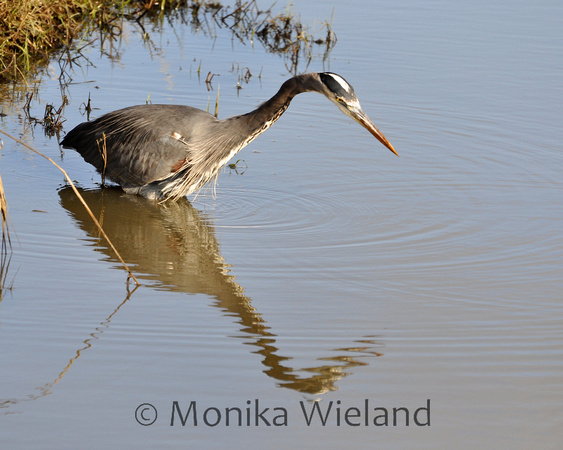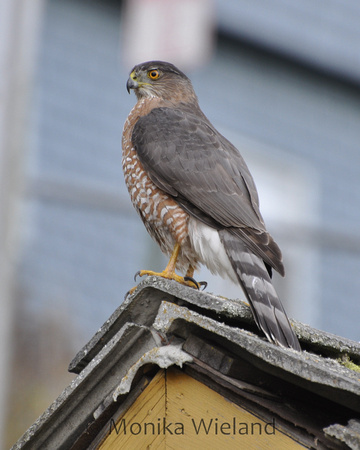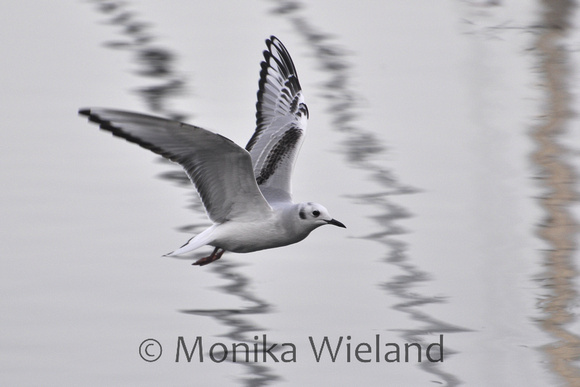I have several blog posts just waiting to be written and lots of photos to share, but I've been thwarted first by a broken computer and now by a lack of internet at home. So until I'm back up and running, here's a quick preview photo of some of what's to come:
For any use of my photos, please contact me at monika.wieland (at) gmail (dot) com
Wednesday, November 30, 2011
Thursday, November 24, 2011
Owl Prowling: The Elusive #200
As I looked over my year and county lists heading down the stretch, I identified owls as a group I could target to pick up some more ticks for both lists. My efforts started on San Juan Island, where I surveyed the prairie habitat at the south end of the island for a snowy owl. It's a bit of a stretch, but sightings do occur every so often on the island and there seems to be a pretty decent flight of snowy owls in western Washington right now with numerous reports around the state. I didn't find one, but I did find a short-eared owl near the Cattle Point lighthouse like I mentioned in my last post.
I got a tip from a friend about a good barn to investigate for barn owls. After talking to the owner, we headed out and climbed up into the loft of an old barn that looked like a perfect hangout for barn owls. We spooked two roosting rock doves out of the rafters, but no owls. Closer inspection turned up a couple of barn owl feathers and some rather fresh-looking owl pellets (including a rodent skull of some sort), so it seems like they're still using the site. It will be worth returning and taking another look, for sure.
Later that same night I recorded some owl vocalizations onto my phone and we headed out to do some nighttime owling. Stopping at some haphazardly chosen locations and playing great horned and western-screech owl calls didn't turn up any responses, though we did see an owl fly across the road, lit up by my headlights. It was too quick to ID, but if I had to guess, I would say it was a barn owl. It was even headed in the direction of the barn we had investigated earlier!
Giving up the county listing efforts for the holiday weekend, we departed in stormy weather on Tuesday afternoon to head south to Portland. When we pulled into Anacortes the overcast conditions and pouring rain made it seem like dusk already at 3 in the afternoon, but I drove south as fast as conditions would safely allow with a particular target in mind. Stanwood, about an hour away, is the site of some of the aforementioned snowy owl reports, and I wanted to swing through and try my luck before continuing on to Portland.
When we pulled off the freeway to head to Stanwood, the streetlights had already turned on. It was another six or seven miles to the place where, I learned from my dad via text message, two snowy owls had been seen earlier in the day along with six short-eared owls. I drove to the end of the dead end country road that had attracted numerous birders over the previous few days and pulled over to overlook the muddy field where all the owl activity had been. Nothing. I scanned with my binoculars, straining my eyes in the dimming light, figuring that if I had been able to see the trumpeter swans we had passed 15 minutes earlier stand out against the dreary background, a pure white snowy owl would be visible, as well. Way in the distance I saw a tiny white speck on a hillside; maybe it was an owl, but there was no way to tell for sure.
It was getting even darker, and the rain was still pouring down. There was another spot a few more miles away that the owls had been reported, and I weighed my options. I knew if I didn't try now, I would be kicking myself and would have to take this detour again on the way north six days later, if the owls were still present. There being no time like the present, we headed even further away from the freeway and the hours of stormy nighttime driving that awaited us. While stopped at an annoying long traffic light, I not so silently cursed myself. This was a stupid thing to be doing, right? It was already so hard to see, certainly not what I would consider bird-watching conditions, and there was a long drive ahead of us. But I was committed at this point, so we went on.
At the end of this next country road I parked and pulled on my rain jacket. The directions said you had to proceed on foot to see the owls. I was looking for the landmark specified in the directions, but after a few moments of walking saw nothing resembling the turn off recommended that would lead the owl seeker up onto the dike overlooking the field where the owls had been seen. Acting impulsively, or perhaps heeded some innate guiding sixth sense, I veered off the trail and scrambled up the muddy slope onto the dike where there was a clearing that looked like it would afford a view to the other side.
Straight in front of me, maybe 100 yards away, was a snowy owl (year bird 200). Unable to believe my eyes, I lifted my binoculars and was just able to make out the movement of the owl turning its head to look directly at me. It had been a somewhat more frustrating journey than I had anticipated to go from 199 to 200, but standing in the chilly rain on a dark November afternoon in a brief stare down with a barely-visible snowy owl also seemed somewhat appropriate.
The rest of the drive to Portland was miserable, the conditions being no more amenable to driving than they had been for bird-watching. But every time I thought of that owl, I was still able to smile. There are many people that probably wouldn't have thought so, but the detour was well worth it.
Sunday, November 20, 2011
A Matter of Record Keeping
It's been a while since I've checked in on where I stand with the year list. I was stalled out for a while at 197, and figured my best shot at pushing over 200 would be when I do some traveling for the upcoming holidays. Then, however, I got an e-mail from Tim over at 39 Counties, who is looking to see 39 species in all 39 of Washington's counties this year (and in fact is close to getting 50 species in every county). He was looking at data on eBird and noticed that I'm within spitting distance of the San Juan County record for species seen within a year. Washington Birder has the record at 156 species, and at the time of the e-mail I had 149 in the county for the year. Of course I can't resist a challenge, so it was time to comb through the species list and renew my efforts birding on the island down the stretch.
The first thing I noticed on my San Juan County species list was the northwestern crow. Personally, I think the American crow and northwestern crow are probably one species, but currently they are considered separate species and the general consensus is that only northwestern crows inhabit the San Juan Islands. If I'm going to count this as a species on my county list, I've got to count it as a species on my year list, right? I hadn't included it as separate from the American crow just yet, so the northwestern crow now occupies the out of order position of 198 on the year list - chintzy, I know.
One species that's been reported around the county recently that I hadn't seen was the ancient murrelet, and I had been trying to see some from shore for quite some time, but without any luck. Lucky for me, my bird-watching friend Phil helped me out and we took a little trip out into San Juan Channel where he had been seeing lots of murrelets. It didn't take us long to locate a few ancient murrelets (year bird 199, county bird 150):
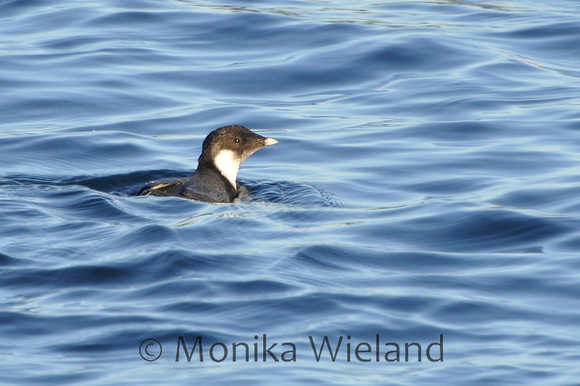 |
| Ancient murrelet in San Juan Channel |
It was a beautiful, calm afternoon - a nice break in some of the stormy weather we've been having - and there was lots of other bird activity out there as well. Bonaparte's gulls, mew gulls, and glaucous-winged gulls, plus common murres, rhinoceros auklets, and loons. We also saw several pairs of marbled murrelets, and I got my best-ever photo-op of this endangered species:
 |
| Marbled murrelets in San Juan Channel |
I've identified 20 possible county species to look for down the stretch, and I've been out several afternoons looking for them since then. No luck just yet, but of course I've seen lots of other cool stuff. I've found two short-eared owls at different locations on the island, found a Eurasian wigeon mixed in with a flock of American wigeon, seen my first trumpeter swans on the winter, and found an impressive flock of 150+ Canada geese (especially large numbers for on the island).
Coming up this week, after scouting out a couple of potential owl locations on the island, we'll be heading to Portland for Thanksgiving. The county birding effort will be put on hold, but I expect to push the year list over 200 on the trip. Dave, my rival year lister, beat me to the 200 mark a good two weeks ago, but of course what really matters is where the count stands at the end of December 31!
So, now that all that record-keeping is out of the way (did you follow all that?), I'll be updating my bird list status more regularly down the home stretch of 2011. What will my 200th year bird be? Will I end the year ahead of Dave? Will I get the county year list record? Stay tuned to find out!!
Friday, November 18, 2011
Off the Dock: Harbor Seals
I've successfully gotten a few more video clips this week of those harbor seals that have been hanging around our marina - here are the results:
Labels:
harbor seal,
music,
seals,
video
Saturday, November 12, 2011
Underwater Video - First Takes
Winters on San Juan Island are very different from summers: the days are short, the weather is wet and gray, and the town is quiet. People get through the winter in different ways, but there are lots of different community activities to help pass the long, dark nights. Sports are my personal favorite. In years past I've played hockey and done rollerblading at open skate, and this year I've tried badminton and indoor soccer as well. This week I ended up doing all four, resulting in various types of soreness as I use muscles that have laid dormant all summer. I thought it was amusing, however, that the thing I was most sore from this week wasn't a sport at all - it was crouching on the dock taking underwater video clips.
I got a Flip video camera for my birthday, along with an underwater case. This is the perfect time of year to put it to good use because the marina is just full of schooling fish, and as a result, lots of other wildlife. We've had groups of seals coming through several times a day, plus different types of gulls and other marine birds, river otters, and the regular assortment of intertidal life.
I still have a long ways to go in getting the types of clips I think might be possible from right off our dock (including getting the camera lined up right in the casing), but here are a few samples from my first week or so of attempts. Featured here are a dock shrimp, a couple schools of fish, a cross jellyfish, a very brief look at a seal (they're proving the hardest so far!), and a Bonaparte's gull:
Wednesday, November 9, 2011
Cooper's Hawk
Another very cool bird sighting from the houseboat - this time it was a Cooper's hawk! At first it was hidden deep within the bushes. It was clearly looking for something as it would occasionally dive down to the ground. It's amazing they don't get hurt or at least damage their feathers flying through all those brambles.
Then it flew out into the open, making for this impressive view:
Not surprisingly, there was no bird activity at our feeders that afternoon! I've wondered a couple times in the past upon finding lots of feathers on the deck if a sharp-shinned or Cooper's hawk might have nailed something at our feeder, but this is the first time I've seen one of these hawks in the vicinity. It's a little sad to think about some of our cute juncos and sparrows getting pegged by this guy, but it's also pretty cool to have gotten such a close up look at this predator.
Sunday, November 6, 2011
Bonaparte's Gulls
The first fall I spent on the houseboat in 2007 I had an amazing encounter with Bonaparte's gulls right off my front porch in September. A couple of photos can be seen here. At the time, I thought maybe it would be a regular occurrence, but I hadn't seen it again until this week. Three Bonaparte's gulls - one adult and two immatures - spent some time flying around the marina and foraging on bait fish. There were a lot of fish around, attracting not only the Bonaparte's gulls but also harbor seals, a belted kingfisher, a mew gull, and a couple of glaucous-winged gulls.
Bonaparte's gulls are probably my favorite gull species to watch. They look so tiny, just half the size of our most common glaucous-winged gull, and appear very buoyant in flight. Sometimes during the spring and fall migration I've encountered flocks of hundreds or even thousands of them, an impressive sight, particularly when they're actively foraging. It was just as neat, however, to have a close up look at these three gulls this week, again right off my front porch.
One fun aspect of photographing wildlife in action is you get to pick up certain things off still photographs that happen to fast to witness when watching live action. For instance, I was surprised at just how far underwater these gulls went when diving for fish - they're not considered diving birds, but they almost completely disappear under the surface! Just part of one wing is visible here, on the left in the middle of the splash:
November is probably about the latest in the year I've seen Bonaparte's gull in the San Juans. It was very cool, and now that I know these close encounters at the marina don't happen all that often, I was especially excited by it!
Wednesday, November 2, 2011
Day of the Dead ~ 2nd Annual Tribute
Last year on November 2nd, the Day of the Dead, I wrote a blog post honoring the Southern Resident Killer Whales that we had lost during the preceding year. I'd like to make this an annual tradition, so here's my second annual Dia de Los Muertos tribute.
 |
| J1 Ruffles, estimated birth year 1950 |
I've already written extensively about Ruffles in a blog post that you can read here, and also honored him with a photo gallery that you can see here. It's still hard to believe that this iconic whale is no longer with us. Seeing J-Pod this year just wasn't the same without the distinct, wavy fin of Ruffles, probably one of if not the most photographed Southern Resident whale. Because of the ease of identifying him, he was especially popular with tourists, many of whom would come back after years of being away and ask about Ruffles. He was also known among local naturalists as "the man", in part because he was the oldest male (by far) in the Southern Resident community. His reputation for being a ladies' man (ladies' whale?) was substantiated by recent genetic research that showed him to be the father of quite a few young whales in the community.
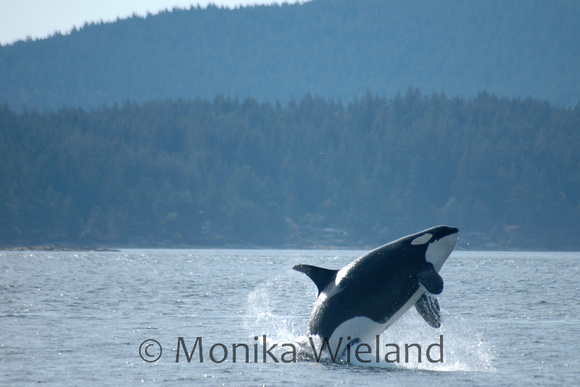 |
| L7 Canuck, estimated birth year 1961 |
When I think of Canuck, an L-Pod whale, the first thing I think of is how she often traveling with J-Pod. For several years in a row it seemed that she, along with her daughter L53 Lulu and adult male L57 Faith, would spend the winters with their closest relatives in L-Pod but spend the summers traveling with J-Pod. In the last couple of years this pod switching and fragmenting has become more common, but at the time it was especially notable for females to be traveling with a different pod. Canuck seemed to have a strong affiliation with both J1 Ruffles and J2 Granny in J-Pod, so perhaps in the absence of strong connections with other whales in her own pod, she and her daughter spent more time with these elder Js.
Canuck and Lulu were inseparable, and from 1987 onwards made up the extent of their immediate living matriline. Canuck only ever had one other known calf that didn't survive its first year of life, though its possible she had other offspring before the whales were studied in detail starting in 1976. Despite their very small family, it seems Canuck and Lulu found somewhat of a surrogate family member in Faith, who was the only living member of his own matriline since his mother L45 Asterix passed away in 1995. Faith seemed to enjoy traveling with the eligible J-Pod bachelorettes, but perhaps he found the mother figure he was lacking in Canuck. Often, adult males don't live too long after their own mother passes away unless they latch on to another older female to help fill that role.
In the Center for Whale Research's genealogy guide, they have L43 Jellyroll as a possible sister to Canuck. Jellyroll, who died in 2006, has two living offspring in L72 Racer and L95 Nigel, who would be Canuck's niece and nephew. It's funny, when I think back on my whale encounters, I wouldn't have said Canuck spent much time with them, but when I look through my notes I find otherwise. I list them as either traveling with or near the L43s quite often when the rest of L-Pod is present.
Regardless of which pod Canuck was traveling with, she was always an easy whale to pick out from a crowd because of her distinct notch about a third of the way down her dorsal fin. From my perspective, that made it easier for me to follow her movements and social associations over the years, because she could be easily identified on sight as well as in photos, and even in poor lighting where her saddle patch wasn't visible. It will be interesting to see how Lulu does in the coming years without her mother, and whether she continues the relationship with the J-Pod whales her mother began or goes back to spending more time with her extended L-Pod family.
It is sad to lose these two whales, but others have been born and have started their own journeys as Southern Resident Killer Whales. This year we welcomed K44, a son born to first-time mom K27 Deadhead; L117, born at the end of 2010 to L54 Ino; and L118 born to L55 Nugget.
Labels:
day of the dead,
J1,
L7,
orcas,
photos
Tuesday, November 1, 2011
Orcas Island Birthday Weekend ~ Part 2
We stayed at The Cabin on Spring Bay, and spent the afternoon Saturday hiking the trails on the property or enjoying the views out the front windows. Here's a picture I took from the water's edge looking back towards the cabin:
The property sits between two ridges, and the trail we took started by climbing up one of the ridges and looking over towards Obstruction Island:
There seems to be more deer on Orcas Island than on San Juan. On Saturday we counted more than 30 for the day! Many of those were at Spring Bay.
Not all the mule deer on Orcas Island look like our San Juan deer, either - numerous animals are speckled with varying amounts of white. I assumed that maybe this was from in-breeding, although I questioned my own theory since I know deer do swim between the islands, which should help diversify the gene pool. After doing a little research, it sounds like the story is that at some point there were one or several pure white deer introduced or otherwise brought to the island. These cross-bred with the native mule deer, creating these variable color morphs. Doesn't this deer also look a little small (young) for this time of year?
There were so many deer around, it seemed like anywhere you looked, you could find one if you looked hard enough.
Back to our hike around Spring Bay.....it was one of those great walks where there's lots of everything to look at. Mushrooms:
Mammals - this is a native Douglas squirrel, much nicer than the large non-native fox squirrels that are most common around Portland. We don't have squirrels on San Juan Island! (Okay, there is a small population of flying squirrels on San Juan, but I've never seen one.)
And birds - the highlight was this barred owl:
We talked to the owner and he said he's only seen maybe three barred owls in the 20 years he's lived there. Nice find! Some other highlights included a pileated woodpecker, and the horned grebes and hooded mergansers that spent a lot of time in the bay itself. Overall, we saw close to 30 species from or around the cabin.
The Saturday evening sunset was pretty stunning:
Right before we left to have a delicious celebratory birthday dinner at the New Leaf Cafe in Eastsound, the moon became visible, too.
Overall it was a fantastic weekend!
Subscribe to:
Posts (Atom)

